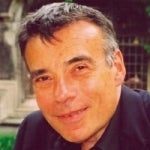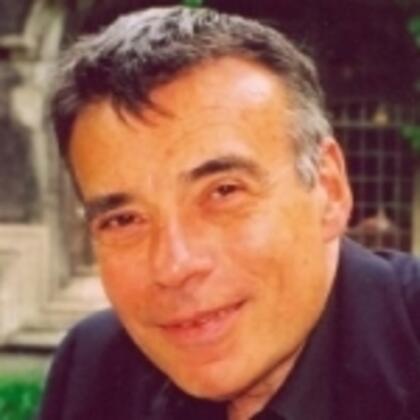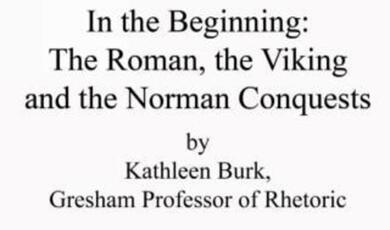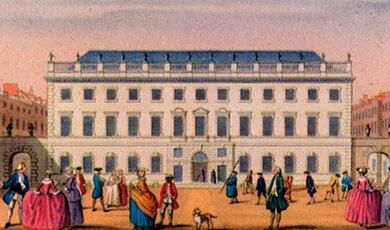Creativity in Art, Creativity in Science
Share
- Details
- Transcript
- Audio
- Downloads
- Extra Reading
In his lecture, Professor Miller will consider the concept of creativity in the context of his research into the history and philosophy of nineteenth and twentieth century science and technology, cognitive science, scientific creativity, and the relation between art and science.
Key questions to be discussed include the following:
Why are some people are more innately talented than others? Can algorithms enable us to better understand the mind of a Bach or a Mondrian? Can computers be genuinely creative? Can discoveries be made while dreaming?
Professor Miller's books include Empire of the Stars and Einstein, Picasso: Space, Time and the Beauty that Causes Havoc, which was nominated for the Pulitzer prize.
Download Transcript
24 October 2013 Creativity in Art, Creativity in Science Arthur Miller Tonight, I am going to talk about creativity in art and creativity in science, which is a very wide subject. Let me begin by talking about creativity in general. Creativity…what an idea! Now, we are all creative – that is another very broad statement, we are all creative – but what is creativity? Can it be defined? I maintain that it can be defined as the production of new knowledge from already existing knowledge or going beyond the given. Basically, creativity is problem-solving. There is nothing romantic in that, but that is the way it is. If you want to become famous, you need a good problem to solve, like a new theory of space and time, solve the situation in Afghanistan, playing a piano concerto, design a better vacuum cleaner, or maybe a better mousetrap. It is in this way you can become more creative, by honing your problem-solving ability. But the $64,000 question is this: how does that all occur? We take in perceptions or data from the world in which we live, and out comes knowledge! What goes on in between? What is the structure of the mind that processes incoming data into knowledge? For insights, I am going to, tonight, look at certain cases of high creativity to see what generalisations we can draw to help us in our daily lives. So, I am going to discuss creativity in art and creativity in science, creativity among artists and scientists and how they mix it up. Alright, you have a problem to solve. You turn it over and over again in your mind and, suddenly, you are walking down the street, maybe thinking of the problem, maybe thinking of something else, maybe thinking of nothing at all, and, wham, the idea pops into your head – aha, eureka, it came to me in a flash! Now, an often-quoted example of this is Archimedes stepping into his bath-tub and realising Archimedes’ principle, that is to say that the density of the material is related to the volume of water that it displaces. Sometimes, a scientist realises the solution to a problem when the scientist has no access to a notebook or to a piece of paper – he grabs whatever is at hand, and this is a real back-of-the-envelope calculation, done by the great French mathematician, scientist and philosopher, Henri Poincaré. Einstein, in 1905, had a chance encounter with a friend, and he realised from this discussion that the nature of time is behind his deliberations and that led to his breakthrough Theory of Relativity. Picasso, in 1907, visits the Louvre to see an exhibition of African masks and he has a revelation. He suddenly realises that what somebody had been telling him about the importance of geometry for a painting becomes relevant, which led to his breakthrough painting, Les Demoiselles d’Avignon. I think we can understand this on the basis of cycles of thought. An artist or scientist sits at their easel or their desk, working consciously on a problem, and then, well, gets stuck. The experienced researcher will cease research, that is to say, sees consciously the passionate, intense desire to solve a problem keeps it alive in the unconscious, where it can be turned over in ways that it cannot be in consciousness, where there are inhibitions, and hopefully the illumination will emerge. Then we have errors, as the great atomic scientist Niels Bohr put it: “An expert is a person who has made all the mistakes that can be made in a very narrow field.” The point is: do not be afraid of errors. Indeed, in experimental labs, the really good scientists are the ones that have a high failure rate. Let me now turn to some examples. I am going to talk first about science-influenced art, and I do not mean science-inspired art. I mean artists who have looked into concepts in science or who have perhaps even worked with scientists. Picasso, in 1907, created Les Demoiselles d’Avignon, a breakthrough painting which contains the seeds of Cubism. I believe that his primary motivations, his primary influences, were recent developments in mathematics, science and technology. Let us just talk about mathematics for just a moment. We can see the effect of mathematics in the face of this demoiselle. She is simultaneously in full-face and profile. Picasso meant her to be a projection from a fourth spatial dimension. Artists interpreted a fourth spatial dimension as a place where, if you could get up into it, then you would see all possible perspectives of a scene at once – looming buzzing confusion. The issue is how you project those perspectives down onto the two-dimensional plane of the canvas. The galling opinion was one at a time, but Picasso wanted it all at once. Well, in this situation, he restricted himself to just two perspectives – full-face and profile. Wassily Kandinsky, in 1910, produced the first abstract work of art. This contains nothing that has to do with forms that we see in the world in which we live. What influenced Kandinsky was not four-dimensional space time, because, according to relativity theory, the fourth dimension is a time dimension, but rather what would become the iconic equation of the 20th Century, E = MC2. Now, E = MC2 relates energy, which is diffuse, to mass, which is localised. Kandinsky’s interpretation was that everything is amorphous. And then we move up into 1931, Salvador Dali’s Persistence of Memory, droopy clocks, tired clocks, because, according to relativity theory, clocks in motion move slower than clocks at rest. Let me now move into the 21st Century with a new form of art. It is a new form of science-influenced art and it is a form of art in which there is some interplay going the other way: science-influenced art, and art-influenced science. Now, our age of technology, we have moved into a new age: we have moved into the age of information. Data visualisation artists use algorithms to bind data in order to represent them aesthetically, and their measure of aesthetics is that, the higher the information content, the greater the aesthetics. The higher the information content in a representation, the greater the aesthetics in that representation. In other words, information content and aesthetics go hand-in-hand. This is an extraordinary extension of the concept of aesthetics into the realm of the age of information. Let me give you some examples of this… This was done by the artist Jonas Loh. It is based on the 2012 Olympics and he entitled it Emoto. It is a representation of emotions, of the number of electronic messages sent at various times during the Games. So, you have an upsurge when there is a great victory or maybe an upsurge when there is an unexpected defeat, and what you have is a sea, a seascape or a mountain range of waves and troughs. This was a relationship among scientific paradigms was done by Bradford Paley, beginning in 2006, and he is tinkering with it as we sit here tonight. What it is is a relationship amongst scientific paradigms. What Paley did was to take 800,000 papers from a science information databank. There were 776 paradigms in those papers, where a paradigm is a model or a theory according to which scientists try to understand data, and what he did was to look for relationships amongst those paradigms, essentially amongst different fields, based on concepts, keywords and references, and what one has is a diagram which looks like a peacock flying, looks like a bird flying. There is a great deal of beauty in it and also a great deal of information content. What one can also do is to peel away layers in this diagram to determine what sciences various countries focus on. So, for example, the United States and the UK focus on biomedical sciences, and France and Germany focus on the physical sciences, chemistry and physics. This is entitled Flight Patterns. It was done by Aaron Koblin, who is the Creative Director of Google’s Creative Arts team, and what it shows is connections amongst cities in the United States as airplanes take off and land. It looks at 250,000 airplane flights on August 12th 2008. Once again, you can peel off layers to look at particular cities and see how many airplanes took off and landed in those cities, and even what the makes of the airplanes are. There seems to be certain places in the United States where there are no planes flying – are they no-fly zones? Is there some sort of a conspiracy going on here…? Data visualisation art was actually going on even before the digital age. It was not called data visualisation art; it was called design. Let me just show you an example that also shows how closely coupled is high information content and aesthetics - the London tube map. This was designed in 1931 by Harry Beck, previous tube maps were based on what is going on above-ground, where the tube stops are above-ground. What Beck did was to focus below-ground, then he could spread out the tube stops and not have to worry about distances between the tube-stops. And notice the very clean horizontal lines, vertical lines, and lines at 45 degrees, just like an electrical circuit diagram, and indeed, Beck was a technical artist. Now, let me show you a diagram that has none of the above. It does not have high information content and it does not have aesthetics either. This is a diagram PowerPoint, drawn in 2010 by the Coalition to show how well we are supposed to be doing in Afghanistan. As the general in charge at that time, Stanley McChrystal, put it: “Once we will have understood this PowerPoint, we will have won the war!” What I have shown you are examples from data visualisation where it is, to a large extent, science-influenced art. There is still some feedback from the other way, from the artist into the science part of it, to build up aesthetics. Let us look at a couple of examples of pure art-influenced science. There are not too many examples of that in the 21st Century, but I think there will be – I am sure there will be. Let us look at Cubism and quantum physics. Niels Bohr, the great atomic physicist, in 1927, concluded that the major problems confronting atomic physics had been solved with the new quantum physics, but scientists were not looking closely at what they were doing. They did not really understand quantum physics. They stayed away from fundamental problems, such as the schizoid nature of the electron, which can be a wave and a particle at the same time – that is unimaginable so it is un-imagable. Bohr was interested in looking at the problems of that sort. It turns out that art, Cubism in particular, offered him a way to look at that and to come to grips with it. Now, Bohr was an urbane scientist. His interests went beyond science into philosophy and art, particularly Cubist art. When he moved to his institute in Copenhagen, he had the support of the Carlsberg Brewery, so he had unlimited amounts of money, and one would have expected, when he furnished his study, that he would purchase a painting by Picasso or Braque. Instead, he purchased a painting by Jean Metzinger done in 1924, entitled the equestrian. I think this choice has a quite special meaning because Metzinger was actually a second-rate Cubist artist but a first-rate propagandist of that genre. In 1912, along with a colleague, Albert Gleizes, he wrote a book entitled “On Cubism”. We may assume that Bohr read that book and was very much taken by this passage: “A Cubist painting represents a scene as if the observer is walking around it in order to seize it from several successive appearances.” I think the import of this passage is better illustrated with another Metzinger’s paintings, done in 1912, entitled Le Gouter, Tea Time. What you have is a bifurcated woman sipping tea from a bifurcated cup. How you look at it, that is what she is - you could look at her in profile, you could look at her in full-face. For Bohr, Cubism went beyond visual perception and, in so doing, shattered the certainty of the object, revealing its ambiguities. In this case, what Bohr had in mind was the wave and particle nature of the electron, and in Cubism, Bohr found a way to come to grips with it, as follows: “It is a fact that an electron is a wave and a particle.” By 1927, that had been established in a laboratory. “Depending upon how you look at it, that is to say, what experimental arrangement is used, that is what it is.” Bohr called this complementarity. Complementarity is far-reaching – it goes beyond physics into philosophy as well. One other example of the effect of art on science is the invention of camouflage by the French Colonel Guirand de Scevola in World War I, who recalled that: “In order to totally deform objects, I employed the means Cubists use to represent them.” There is a story that, during World War I, Picasso and Gertrude Stein were watching a parade in Paris and they saw a camouflaged truck go by, and Picasso said to Stein, “We did that!” – and indeed they did. Let us look into aesthetics in art and science, aesthetics as a driving force. On the very first page of Einstein’s relativity paper, he writes that Maxwell’s electrodynamics, “…the way in which it is usually understood, when applied to moving bodies, leads to asymmetries that do not appear to be inherent in the phenomenon is well-known.” Clearly, Einstein’s arguments, his qualms, his dissatisfaction, were not with the equations of physics, but with the way that they were interpreted. They were interpreted in ways that led to asymmetries that, to him, were not inherent in nature. He wrote, not too long after this, that he found the situation unbearable. What he did was to use a minimalist aesthetic to pare away inessential concepts and redundant explanations, and the result was the Theory of Relativity, which was a response to his aesthetic discontents. The flamboyant American physicist Richard Feynman recalled: “There was a moment when I knew how nature worked. The theory had elegance and beauty. The goddamn thing was gleaming.” What he was recalling was a theory that he had devised in 1958, along with a colleague, Murray Gell-Mann. It was a theory that described a certain class of interactions among elementary particles, radioactivity, more technically known as the weak interactions, and they made a prediction upon which the theory rested. It was an extremely important prediction. Experimentalists carried out the experiment and it came out to disagree with the theory. Now, there are various moves that scientists can make at this point: they can abandon the theory, but, as Feynman put it, “It had elegance and beauty.” What did he mean by that? What he meant by that is that the theory was capable of being generalised to include other interactions among elementary particles, as indeed it pointed the way to combining, unifying the electromagnetic interactions with the weak interactions, called the electro-weak theory. As the great French mathematician, philosopher and scientist, ever-quotable, put it: “The scientist does not study nature because it is useful; he studies it because he delights in it, and he delights in it because it is beautiful.” Let me return to this slide, and let me say a few more words contrasting beauty and art, even contrasting within beauty and art, and beauty and science. I mean, everybody agrees this is beautiful. The discus thrower, the elegance, the form, the symmetry, the discus – you can almost feel the discus thrower tensing his body to convert that potential energy into kinetic energy and hurl that disc. This is an acquired taste. To me, this is beautiful. To me, this is beautiful because – this is part of Les Demoiselles d’Avignon and I showed you this before. This is beautiful because it was an attempt by Picasso to look beyond appearances, just like scientists look beyond the appearances. For Picasso, art was research. Now, this might look like hieroglyphics. As a matter of fact, I was once at a meeting in Erice, in Sicily, one of the oldest still-inhabited cities in the Western hemisphere. Everybody passed through it and sacked it – the Phoenicians and the Romans, etc. It is a beautiful lecture hall and, in front of the desk that rises above the floor, there is this equation, which is called a Dirac equation. It was discovered by Paul Dirac, the great British physicist, and it was written in Dirac’s handwriting, a typical scientist’s characteristic handwriting. There were two doctors standing next to me and one said to the other one, “I guess this is a very old place – the Egyptians were here too. That must be hieroglyphics.” Well, it is not, and it tells you how electrons move. It is beautiful because if I have an electron sitting on this table, it is at a particular place, in a particular time. If I move these coordinates, either physically or just mathematically, to another laboratory on the Earth, or even to a star system trillions of miles away, this equation will maintain its form, and the symmetry, just like one says, this possesses symmetries. Well, this possesses a symmetry too. It is a very abstract symmetry. It is called Lorentz invariance. It is symmetrical under relativity theory. It maintains its form, wherever you go in the universe. Let me sum up what I have been saying thus far, and let me use Einstein and Picasso as an example, that at the nascent moment, that nascent or magical moment of discovery, boundaries blur between art and science, and both artists and scientists think along the same conceptual lines. In the case of Einstein and Picasso, it was the discovery of a new aesthetic: for Einstein, the aesthetic of minimalism; for Picasso, the aesthetic of reducing forms to geometry, which would be the bedrock of Cubism. As I noted at the beginning, if you want to become famous, if you want to do something creative, you have to have a problem to solve. Most scientists, probably 99.9% of scientists, and artists, for that matter too, who do research, work on problems that everybody agrees is an issue, to make the theory better, to look at further tests, to extend the theory, to solve certain outstanding problems with the theory, but then there is that one-tenth of one percent of people who discover problems. Einstein discovered problems, Heisenberg, Picasso also. So, problem-discovery is an important part of creativity. Work hard to prime unconscious thought, so as to hopefully allow the solution to emerge. Do not fear errors. And the list can get longer – let us say more details another time. Focus is very important. These great artists and great scientists just focus on what is in front of them and push out everything else out of their lives. For example, Einstein and Picasso cared very much for the human race but not very much for people around them. Can computers be creative? In 1965, when computers were first coming online, so to speak, in a big way, to solve scientific problems, computers that filled an entire room, rooms bigger than this, and had less power than that tiny laptop does. An engineer by the name of A. Michael Noll, working at Bell Telephone Laboratories in New Jersey – this was American telephone and telegraph’s premier innovative laboratory – Noll thought why not use computers to do more than solve equations mathematically and then plot out the numbers that are crunched out? Noll was an aficionado of the arts. He felt that why not have a computer art? Amongst the artists that Noll preferred was Piet Mondrian, and in particular, Noll was interested in a series of paintings that Mondrian had been working on since 1917, which Mondrian called Composition with Lines. What they are, essentially, are vertical and horizontal lines, maybe in different colours. What Noll did was to write an algorithm. An algorithm is a solution to a problem. Noll’s problem was to connect randomly spaced points with horizontal lines and vertical lines, and then compare it with the original Mondrian, and let us see what happens, so this is what he did. What Noll did was to take a survey amongst a hundred people at Bell Labs, amongst some very brilliant scientists, and technical personnel also who were quite smart. Only 28% picked the correct Mondrian. But what was even stranger is that, even when they were told which was the correct Mondrian, they preferred the computer Composition with Lines – 59% did – because it looked more random, and they associated randomness with creativity. Now, that was 1965, and decades have passed by. Construction of algorithms has become much more sophisticated. Algorithms have been produced which can generate music, classical music too. David Cope is a computer scientist and a musician, and he has created an algorithm to generate classical music, particular music that is like Bach, which is almost indistinguishable from the music of Bach. Let me show you… [First piece of music plays] [Second piece of music plays] Okay. The first one and the second one… In other words, you cannot tell… [Audience] Yeah, second one, yeah. I especially used the tinny recording because the first one came out of a computer. Yeah, obviously, he had some trouble doing it. And that is interesting, and considered to be interesting with experimental musicians because maybe there is something in these algorithms that can give you some clue, you can tap into Bach’s mind, how he created music, and what his sense of aesthetics was. This is a theme that is studied by experimental musicians, in collaboration with mathematicians and neuroscientists and I think that this procedure is, to me, better than what is going on in what is called neuro-aesthetics today, which puts enormous amount of emphasis on functional magnetic resonance images. Now, algorithms can also produce beautiful art. This was from an algorithm called Electric Sheep by the computer scientist and artist Scott Draves. This is one of the images that it continually produces. I think it is beautiful! It is symmetrical, it is swirling, looks dramatic, it is moving – it is like you are looking into another part of the universe, or you are looking at the quantum phone maybe. And the way Draves works is that the science feeds back into the art, and the art feeds back into the science, to make a more aesthetic art. Draves works extremely close with, almost at one with a computer. When I interviewed him recently for a forthcoming book of mine, I asked him “What came before computers for you?” and he said “There was no before.” For Draves, as he put it, “I believe that computation can reproduce the whole creative process, that, ultimately, computers can have soul.” I mean, to me, this process of looking into algorithms, and how algorithms can tap into the mind, is extremely deep and interesting because, for me, Einstein and Bach touched the cosmos, so it is nice to to get some inkling of how they thought. For more details of what I have said today, there are two published books of mine: “Einstein, Picasso”, “Insights of Genius” – it is not my autobiography, it is a study of imagery and science in research. And my website, arthurimiller.com, and stay tuned for my forthcoming book “Colliding Worlds – How Cutting Edge Science is Re-defining Contemporary Art.” © Arthur Miller, 2013
This event was on Thu, 24 Oct 2013
Support Gresham
Gresham College has offered an outstanding education to the public free of charge for over 400 years. Today, Gresham plays an important role in fostering a love of learning and a greater understanding of ourselves and the world around us. Your donation will help to widen our reach and to broaden our audience, allowing more people to benefit from a high-quality education from some of the brightest minds.


 Login
Login







